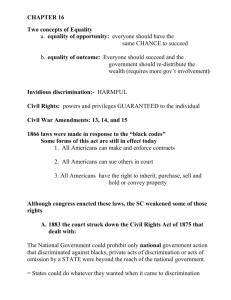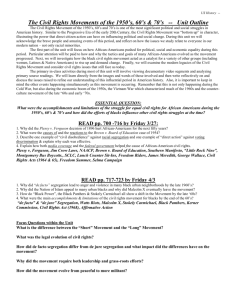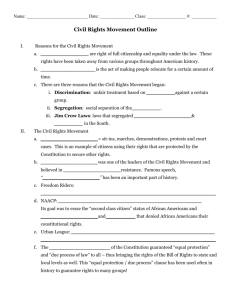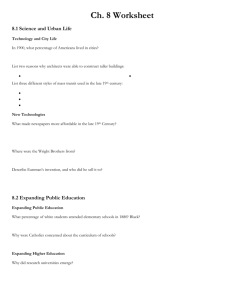AP Government Chapter 16, Assign. #1 - Juarez AP GOV
advertisement
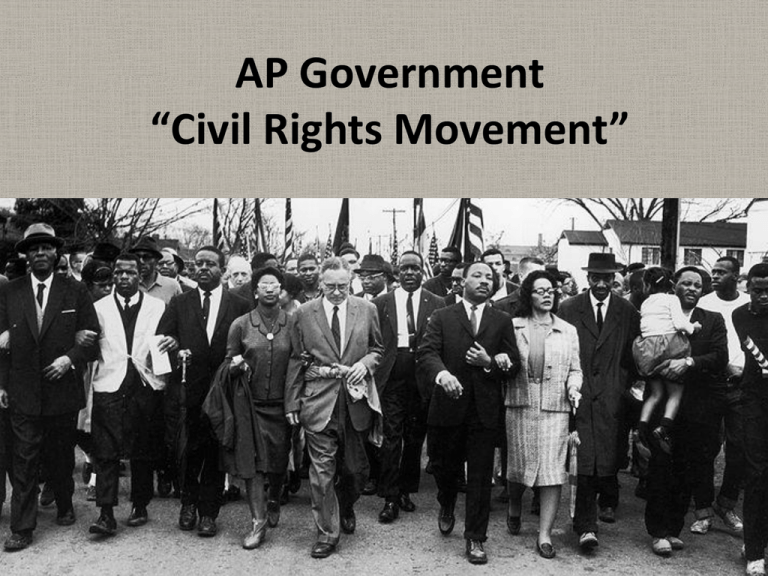
AP Government “Civil Rights Movement” (1 & 2) Two Concepts of Equality • Equality of opportunity – Idea that each person is guaranteed the same chance to succeed in life • Equality of outcome – Idea that society must ensure that people are equal, and gov’ts must design policies to redistribute wealth and status to achieve social and economic equality • Americans are less committed to equality of outcome – Americans prefer merit-based admissions and employment over preferential treatment (affirmative action) – Leads to reverse discrimination – “The way to stop discrimination based on race is to stop discriminating based on race” – Chief Justice Roberts (3) Civil War Amendments • 13th Amendment – made slavery illegal • 14th Amendment – made all people born in the U.S. citizens (including former slaves) – guaranteed all citizens due process under the law • 15th Amendment – Right of citizens to vote shall not be denied based on race, color, or previous condition of servitude Problems for Freed Slaves • Black codes – laws passed by former slave states to restrict the freedom of blacks • Civil Rights Acts of 1866 and 1875 attempted to protect black citizens from these laws – Allowed all citizens to make contracts, sue each other in court, inherit, buy and sell property, and have equal access to public facilities • Nonetheless, with the removal of federal troops from the South following the Presidential election of 1876, Reconstruction ended • Jim Crow laws followed which restricted rights for African Americans and set up segregation (4) Supreme Court and Civil Rights • The Court ruled in 1873 that people were citizens of both the national and state gov’ts, and that states did not have to honor rights guaranteed by US citizenship • In 1876 the Court ruled that Congress didn’t have the power to punish those who violated the rights of blacks within states • Also in 1876, it ruled that the 15th Amendment did not guarantee the right to vote, but listed the grounds by which the right to vote could not be denied (which led to the poll tax and other restrictions on black voting) • 1883 ruling struck down the public accommodations section of the Civil Rights Act of 1875 saying that it could only prohibit gov’t acts of discrimination not private acts (5) NAACP Challenges • Plessy v. Ferguson (1896) – upheld state-imposed racial discrimination if it was “separate but equal” • National Association for the Advancement of Colored People (NAACP) was founded in 1909 by WEB Dubois and others with the goal of ending racial discrimination and segregation • NAACP twofold strategy – press for full equal facilities for blacks – Prove the unconstitutionality of segregation through legal challenges (6) Supreme Court and Segregation • Sweatt v. Painter (1950) – ruled separate law school in Texas for black students was inferior and black students needed to be admitted into the white law school • Brown v. Board of Education of Topeka, Kansas (1954) – ruled separate schools were inherently unequal • This ruling overturning Plessy v. Ferguson and led to the end of segregation • Brown v. Board II (1955) – Court ruled that school systems needed to desegregate “with all deliberate speed” (6) Further Supreme Court Rulings • Loving v. Virginia (1967) – invalidated laws prohibiting interracial marriage • Swann v. CharlotteMecklenburg County Schools (1971) – allowed the ordering of busing of children to ensure school desegregation (7) De Jure v. De Facto Segregation • De jure segregation – gov’t imposed segregation • De facto segregation – segregation that is not the result of gov’t influence, but of common private practice • It is easier to rid the nation of de jure segregation by overturning the laws that create it • Ending discrimination through de facto segregation much harder (8) Civil Rights Leaders • Rosa Parks and Montgomery bus boycott essentially began the modern civil rights movement for AfricanAmericans • The movement fell under the leadership of Martin Luther King, Jr. and the SCLC • Tactics included boycotts, nonviolent marches in protest, civil disobedience to unjust laws, sit-ins (9) Civil Rights Legislation • Civil Rights Act of 1964 – among its provisions it ended segregation, established right to equal employment opportunities, and set up the Equal Employment Opportunity Commission • 24th Amendment (1964) – banned poll taxes • Economic Opportunity Act (1964) – provided education and training to combat poverty • Voting Rights Act of 1965 – allowed Justice Dept. to monitor voter registration in the South (which doubled in the next 5 years) • Fair Housing Act (1968) – banned discrimination in the rental and sale of most housing
